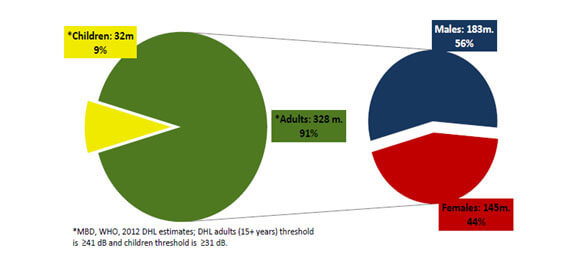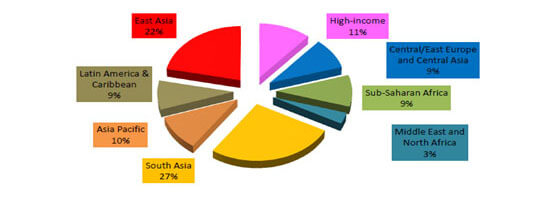Hearing loss can be present at birth (congenital) or become evident later in life (aquired deafness). The distinction between acquired and congenital deafness specifies only the time that the deafness appears. It does not specify whether the cause of the deafness is genetic (inherited).
Acquired deafness may or may not be genetic. For example, it may be a manifestation of a delayed-onset form of genetic deafness. Alternatively, acquired deafness may be due to damage to the ear from noise.
Congenital deafness similarly may or may not be genetic. For example, it may be associated with a white forelock and be caused by a genetic disease called Waardenburg syndrome. In fact, more than half of congenital hearing loss is inherited. Alternatively, congenital deafness may be due to something such as therubella virus to which the mother was exposed during pregnancy.
Hearing loss and deafness(WHO)
A person who is not able to hear as well as someone with normal hearing – hearing thresholds of 25dB or better in both ears – is said to have hearing loss. Hearing loss may be mild, moderate, severe or profound. It can affect one ear or both ears, and leads to difficulty in hearing conversational speech or loud sounds.
‘Hard of hearing’ refers to people with hearing loss ranging from mild to severe. They usually communicate through spoken language and can benefit from hearing aids, captioning and assistive listening devices. People with more significant hearing losses may benefit from cochlear implants.
‘Deaf’ people mostly have profound hearing loss, which implies very little or no hearing. They often use sign language for communication.
Types of hearing loss
Mild hearing lossOn average, the most quiet sounds that people can hear with their better ear are between 25 and 40 dB. People who suffer from mild hearing loss have some difficulties keeping up with conversations, especially in noisy surroundings.
Moderate hearing lossOn average, the most quiet sounds heard by people with their better ear are between 40 and 70 dB. People who suffer from moderate hearing loss have difficulty keeping up with conversations when not using a hearing aid.
Severe hearing lossOn average, the most quiet sounds heard by people with their better ear are between 70 and 95 dB. People who suffer from severe hearing loss will benefit from powerful hearing aids, but often they rely heavily on lip-reading even when they are using hearing aids. Some also use sign language.
Profound hearing lossOn average, the most quiet sounds heard by people with their better ear are from 95 dB or more. People who suffer from profound hearing loss are very hard of hearing and rely mostly on lip-reading, and/or sign language.
Causes of hearing loss and deafness
-
Congenital Causes
- • maternal rubella, syphilis or certain other infections during pregnancy;.
- • low birth weight;
- • birth asphyxia (a lack of oxygen at the time of birth);
- • inappropriate use of ototoxic drugs (such as aminoglycosides, cytotoxic drugs, antimalarial drugs and diuretics) during pregnancy;
- • severe jaundice in the neonatal period, which can damage the hearing nerve in a newborn infant.
Congenital causes lead to hearing loss being present at or acquired soon after birth. Hearing loss can be caused by hereditary and non-hereditary genetic factors or by certain complications during pregnancy and childbirth, including:
-
Acquired causes
- • Acquired causes lead to hearing loss at any age.
- • Infectious diseases such as meningitis, measles and mumps can lead to hearing loss, mostly in childhood, but also later in life.
- • Chronic ear infection, which commonly presents as discharging ears, can lead to hearing loss. In certain cases this condition can also lead to serious, life-threatening complications, such as brain abscesses or meningitis.
- • Collection of fluid in the ear (otitis media) can cause hearing loss.
- • Use of ototoxic drugs at any age, such as some antibiotic and antimalarial medicines for example, can damage the inner ear.
- • Head injury or injury to the ear can cause hearing loss.
- • Excessive noise, including working with noisy machinery, and exposure to loud music or other loud noises, such as gunfire or explosions, can harm a person’s hearing.
- • Age-related hearing loss (presbycusis) is caused by degeneration of sensory cells.
- • Wax or foreign bodies blocking the ear canal can cause hearing loss at any age. Such hearing loss is usually mild and can be readily corrected.
- • Among children, chronic otitis media is the leading cause of hearing loss.
-
Statistics
- • About 2 to 3 out of every 1,000 children in the United States are born with a detectable level of hearing loss in one or both ears.
- • More than 90 percent of deaf children are born to hearing parents.
- • One in eight people in the United States (13 percent, or 30 million) aged 12 years or older has hearing loss in both ears, based on standard hearing examinations.
- • Men are more likely than women to report having hearing loss.
- • About 2 percent of adults aged 45 to 54 have disabling hearing loss. The rate increases to 8.5 percent for adults aged 55 to 64. Nearly 25 percent of those aged 65 to 74 and 50 percent of those who are 75 and older have disabling hearing loss.
- • The NIDCD estimates that approximately 15 percent of Americans (26 million people) between the ages of 20 and 69 have high frequency hearing loss due to exposure to noise at work or during leisure activities.
- • Roughly 10 percent of the U.S. adult population, or about 25 million Americans, has experienced tinnitus lasting at least five minutes in the past year.
- • Five out of 6 children experience ear infection (otitis media) by the time they are 3 years old.
(by the National Institute on Deafness and Other Communication Disorders .NIDCD).
Among adults aged 70 and older with hearing loss who could benefit from hearing aids, fewer than one in three (30 percent) has ever used them. Even fewer adults aged 20 to 69 (approximately 16 percent) who could benefit from wearing hearing aids have ever used them.As of December 2012, approximately 324,200 people worldwide have received cochlear implants. In the United States, roughly 58,000 adults and 38,000 children have received them.
The causes of hearing loss and deafness can be divided into congenital causes and acquired causes.
Definition of disabling hearing loss
Disabling hearing loss refers to hearing loss greater than 40 dB in the better hearing ear in adults (15 years or older) and greater than 30 dB in the better hearing ear in children (0 to 14 years).
Prevalence of hearing loss: WHO global Disabling hearing loss is unequally distributed across the world
Disabling hearing loss is unequally distributed across the world

-
References
- • (European Group on genetics of hearing impairment. Martini A (Ed.), European Commission Directorate, Biomedical and Health Research Programme (HEAR) Infoletter 2, November 1996)
- • by the National Institute on Deafness and Other Communication Disorders .NIDCD
- • Mortality and Burden of Diseases and Prevention of Blindness and Deafness WHO, 2012
- • www.google books.com
